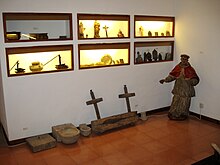Artà Regional Museum
 Museum entrance on Carrer de l'Estel |
|
| Data | |
|---|---|
| place | Artà |
| Art | |
| opening | 1927 |
The Regional Museum of Artà ( Catalan Museu Regional d'Artà , Castilian Museo Regional de Artá ) is a museum on the Spanish Balearic island of Mallorca . It is located in the northeast of the island in the center of the city of Artà , the capital of the municipality of the same name. The museum is located on the second floor of a bank building on Carrer de l'Estel (“Sternstrasse”) right next to the town hall.
history
The Regional Museum of Artà was founded in 1927 on the initiative of Mossèn Llorenç Lliteras i Lliteras (1893–1973), history professor at the seminary of Mallorca, by a group of scholars from the city of Artà. The ornithological collection of the pharmacist and journalist Llorenç Garcías i Font (1885–1975) from Artà with his 257 bird specimens from 118 different species was included in the museum . The purpose of founding the museum was to study historical, archaeological and cultural aspects of the region around Artà. In addition to the collection of the Llorenç Garcías, donations from private individuals and finds from archaeological excavations carried out by the museum were added to the museum's holdings. Since 2005 the museum has been a foundation as Fundació Museu Regional d'Artà . At the moment (2018) some of the rooms are not open to the public and the exhibits have been moved to the depot.
Showrooms
Natural history collection
The natural history collection is housed in three rooms of the museum. It consists of the ornithological collection from the early days of the museum, which has been completed by private donations over time, as well as other specimens from mammals, reptiles, molluscs and insects native to Mallorca. Interesting fossil finds are also on display. Almost all of the exhibits come from the Península de Llevant ("Peninsula of the East"), also known as the Artà Peninsula.
Archaeological collection
In the two exhibition rooms of the archeology department there are mostly finds from the time of the Talaiot culture from 1000 to 123 BC. BC, but also some exhibits from Roman times. The most important sites of the Talaiotic artifacts are the Santuari de Son Mari, Son Favar, Son Baucà, Els Fiters, Son Jaumell, Sa Cova, Es Morro and Sa Carrotja . Within the exhibition, the talaiotic finds are divided into two thematic areas, burial culture and the religious world.
The latter include finds from holy places, square structures with a concave facade and an outstanding wall on which ritual acts were practiced. Remnants of animal bones, bronze statues and ceramic materials such as the so-called copes crestades were discovered here . Right at the entrance to the archaeological department, next to the stairwell, visitors are greeted by five bronze warrior figures, known as Mars Balearicus . Four of them are copies of the bronze sculptures found in Son Favar near Capdepera . The middle bronze cast comes from Son Amer at Son Carrió , a warrior figure with a shield on the left arm, unlike the other figures . Further finds are kept in the glass showcases in the room.
- Department of archeology of the museum
The burial culture mainly includes personal grave goods, such as spiral bracelets, rings and necklaces made of glass paste , which allow contacts to the Phoenician culture to be assumed. But there are also weapons and ritual objects among them. These include different forms of swords as well as double-edged axes, bells, discs and clubs. Ceramics, which by their shape served as drinking vessels, give evidence of the funeral rituals of the Talaiotic period. The small parts are mainly in showcases, while larger finds are openly displayed in the room. The latter also include Greek and Roman amphorae and a Roman tombstone.
Ethnological collection
The ethnological section contains a collection of numerous everyday objects from the last centuries from the Artà area. This includes household utensils, small Christian-religious arts, handicraft tools , Mallorcan fabrics and textiles, handicraft products and various musical instruments such as a clavichord . Among the hand tools there is a complete collection of tools for the manufacture of products from palm leaves of the dwarf palm , the basket weaving (obra de llatra) that was widespread around Artà in the past .
The ethnological collection forms the smallest part of the museum's exhibition space. The room intended for them is located directly next to the archeology department. If you leave the room for Ethnology toward the stairwell can be there on the wall a copy of the Catalan world atlas consider which was built around 1375 in Mallorca and in the original under the signature Espagnol 30 (also Esp. 30 ) in the National Library of France in Paris is . The Portolan cards of the six double images come from the card workshop of Abraham and Jehuda Cresques .
Individual evidence
- ↑ Regional Museum Artà. Retrieved October 11, 2010 .
- ^ Equipaments Mallorca - Museu Regional d'Artà. Retrieved October 11, 2010 .
- ↑ Jaume Alzina Mestre, Jaume Guiscafrè Danús: Artà, living cultural heritage . Cultural guide. Edicions de Turisme Cultural, Palma 2001, ISBN 84-95572-15-X , p. 46 .
- ↑ a b c d Cati Artigues, Irene Cabrer: Fundació Museu Regional d'Artà , information sheet of the museum
Web links
- Regional Museum of Artà ( Memento from March 19, 2005 in the Internet Archive ) (German)
Coordinates: 39 ° 41 ′ 42 " N , 3 ° 21 ′ 4.5" E





